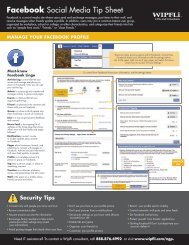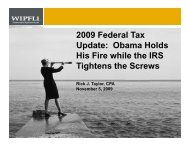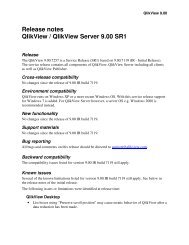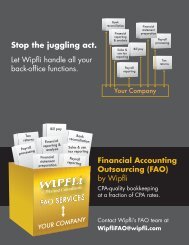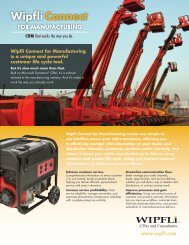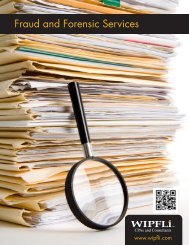Download PDF - Wipfli
Download PDF - Wipfli
Download PDF - Wipfli
You also want an ePaper? Increase the reach of your titles
YUMPU automatically turns print PDFs into web optimized ePapers that Google loves.
Australia Update continued<br />
the existing Petroleum Resource Rent Tax (PRRT) to include<br />
all petroleum projects on Australian territory, either at sea or<br />
on land. This will be associated with a general reduction in<br />
the income tax rate for companies. These changes are<br />
proposed to start from 1 July 2012.<br />
Australia is experiencing a two-speed economy with industries<br />
associated with resource extraction enjoying boom times<br />
while other industries are feeling some of the contraction<br />
that most of the rest of the world is experiencing following<br />
the global financial crisis. The proposed reduction in the<br />
general company tax rate and the imposition of the resources<br />
rent taxes may help to spread some of the advantages of<br />
the resources boom to the rest of the Australian Economy.<br />
The report to Government that recommended this approach<br />
suggested a wide ranging resources rent tax with a reduction<br />
in the company income tax rate from 30% to 25%. However,<br />
due to various political problems and lobbying by vested<br />
interests, the resource rent tax has been limited to a few<br />
high value commodities such as coal, iron ore, petroleum<br />
and natural gas. The reduction in company tax rate has also<br />
been limited to a 1% decrease from 30% to 29% (with a<br />
promise to consider further reductions in the future).<br />
Mining Resources Rent Tax<br />
This tax will apply from 1 July 2012 to iron ore and coal<br />
producers with MRRT profits of at least $50 million per<br />
annum. Smaller producers are exempt from MRRT but they<br />
will have compliance and record keeping requirements.<br />
The MRRT is a tax on the value of the extracted iron ore or<br />
coal at the taxing point, which is generally when the taxable<br />
resource leaves the 'run-of-mine' stockpile, less the costs<br />
incurred in getting the commodity to the taxing point (known<br />
as upstream costs). This calculation is designed to identify<br />
the value of the resource as it leaves the ground and before<br />
further processing occurs. The MRRT profit is further reduced<br />
by an allowance for any State or Territory Government<br />
royalties paid on the extracted resource and also an<br />
allowance for past year losses on the project. The result<br />
is the MRRT profit.<br />
The rate of tax applied to the MRRT profit is 30%. However,<br />
this is decreased by a 25% extraction factor, which reduces<br />
the effective tax rate to 22.5%. The extraction factor is an<br />
approximation of the value of the miner's specialist skills<br />
used to extract the resources and bring it to the taxing point.<br />
The liability to tax will commence at profits of $50 million but<br />
with a phase in for profits up to $100 million so the full tax is<br />
only payable once profits exceed $100million.<br />
Pre-May 2010 Projects<br />
The MRRT only applies to new projects that start after<br />
1 May 2010 (the date of the Government's announcement<br />
for a resource rent tax) and to the increase in value of existing<br />
projects as at 1 May 2010. Taxpayers with projects that are<br />
in existence at 1 May 2010 have to identify the value of their<br />
project's starting base. The starting base is the value of the<br />
project as at 1 May 2010 plus certain capital expenditure<br />
incurred between 2 July 2010 and 30 June 2012 (the start<br />
date for the MRRT). The starting base can be written off<br />
against the MRRT profits over time.<br />
Petroleum Resource Rent Tax<br />
The PRRT currently applies only to certain offshore petroleum<br />
projects but from 1 July 2012 it will also apply to all offshore<br />
and onshore oil, gas and coal seam methane projects,<br />
including the North West Shelf project but excluding projects<br />
in the Timor Sea joint development area. There is no<br />
threshold before PRRT applies, unlike the MRRT with its<br />
$50M threshold.<br />
The PRRT will continue to apply at the rate of 40% of PRRT<br />
assessable profits. These will generally be calculated in<br />
accordance with the prevailing PRRT rules with some<br />
adjustments including:<br />
■ Projects transitioning into the PRRT may apply the<br />
starting base for their project to be written off against<br />
PRRT profits; and<br />
■ All royalties paid to State and Territory Governments<br />
will be credited against PRRT.<br />
3.Tax Exemption for<br />
Non-residents Managed Funds<br />
The Australian Government has announced concessions<br />
that will exempt some non-residents with managed funds<br />
from Australian tax.<br />
These concessions are to apply to foreign investment funds<br />
6 // PKF International Tax Alert All Regions<br />
Issue 8 November 2011






